Strategic Management Report: Stakeholder and Shareholder Interests
VerifiedAdded on 2023/06/11
|11
|2929
|303
Report
AI Summary
This report provides a detailed analysis of the contrasting views of stakeholders and shareholders in corporate governance. It explores the stakeholder principle, highlighting the differences between internal and external stakeholders and comparing their interests with those of shareholders. The report discusses corporate governance in relation to stakeholder interests, including the maximization of profit and the impact of insider interests. A case study of mandatory employee representation, particularly within the German model, is examined, along with the positive consequences of employee involvement in corporate governance. The influence of market control and management-labor relationships is also analyzed, using the Gucci story as an example of how employee interests can be invoked in hostile bids. The report concludes by emphasizing the shift from traditional capital-labor conflicts to new conflicts between strong and weak insiders, advocating for multilateral contracts to effectively manage governance and labor in stakeholder-driven societies. Desklib provides access to this and many other solved assignments.
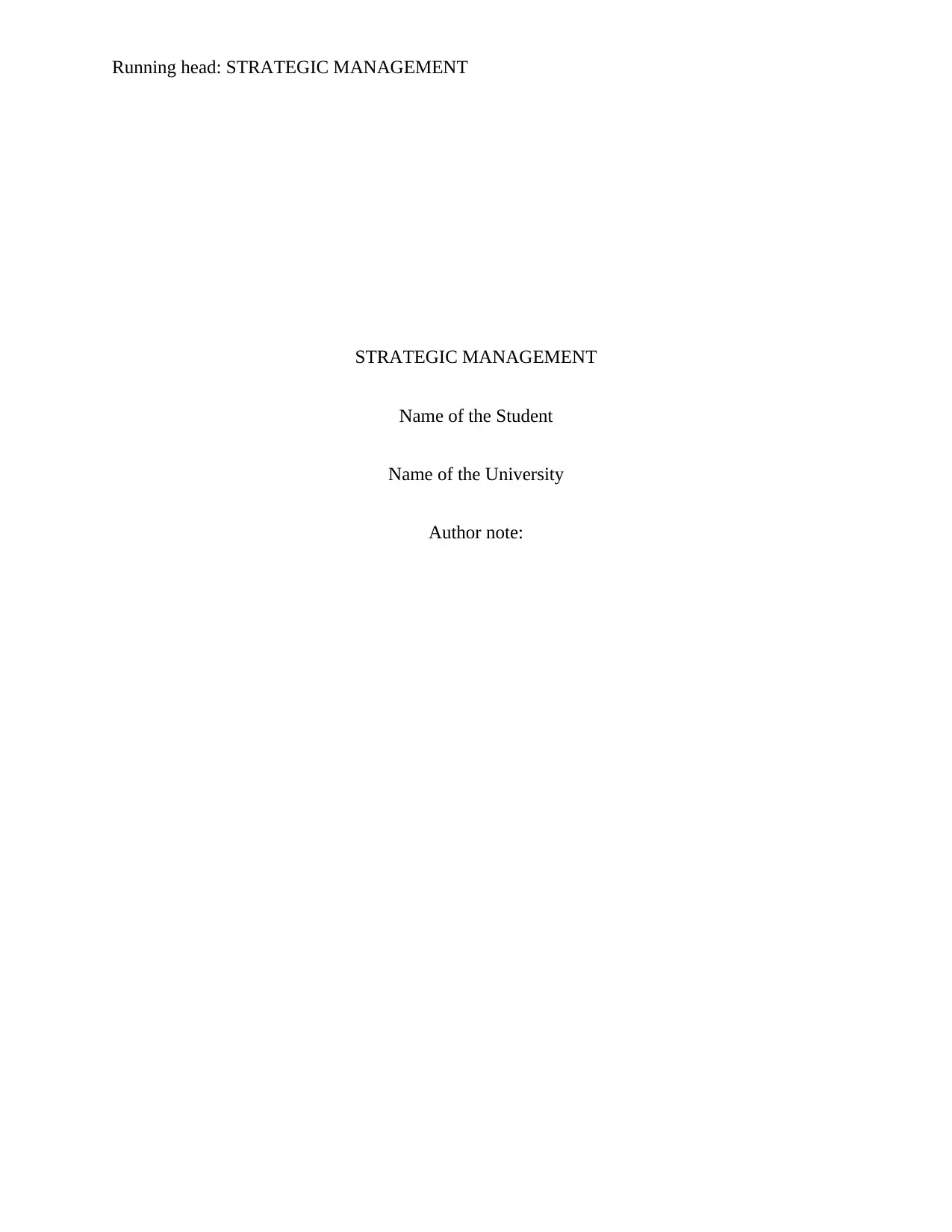
Running head: STRATEGIC MANAGEMENT
STRATEGIC MANAGEMENT
Name of the Student
Name of the University
Author note:
STRATEGIC MANAGEMENT
Name of the Student
Name of the University
Author note:
Paraphrase This Document
Need a fresh take? Get an instant paraphrase of this document with our AI Paraphraser
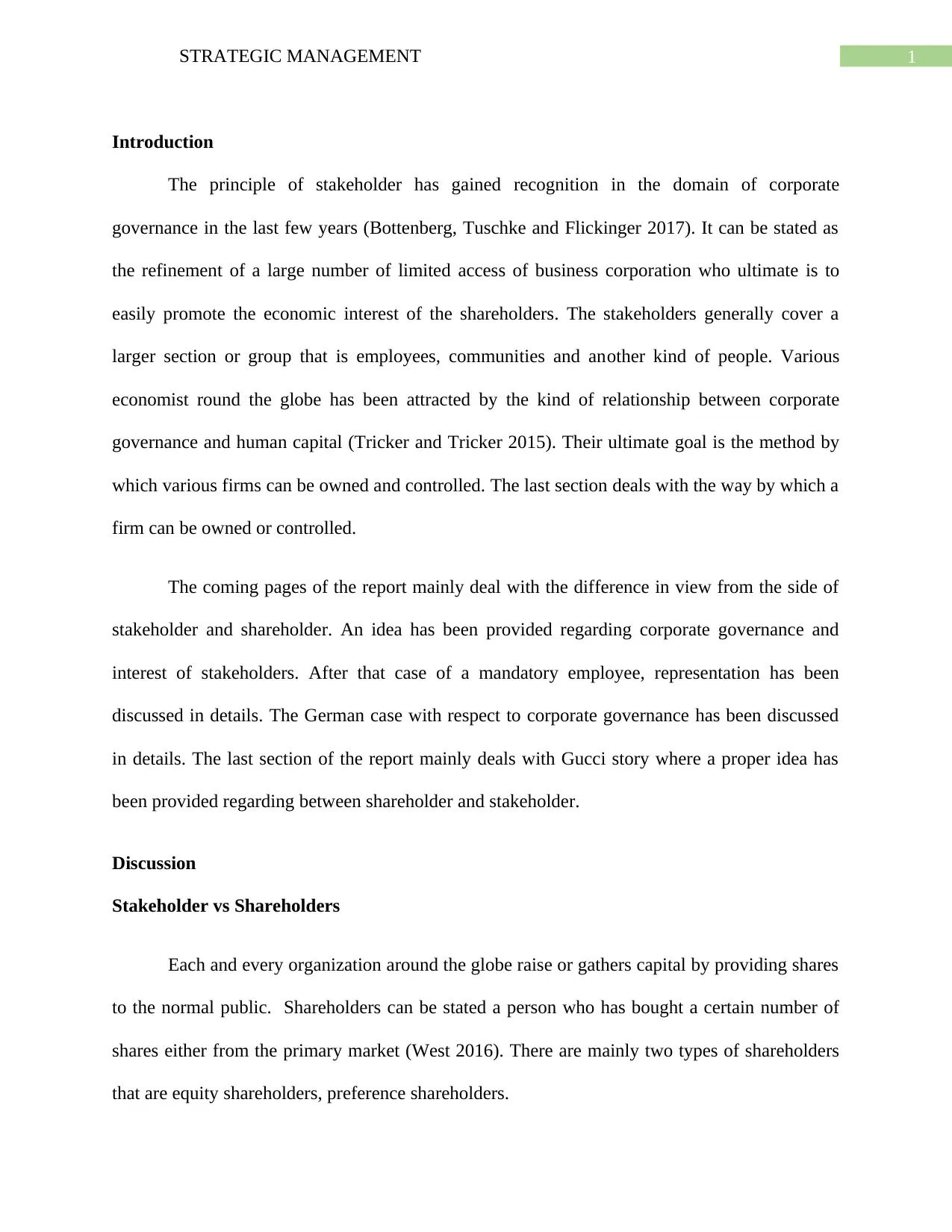
1STRATEGIC MANAGEMENT
Introduction
The principle of stakeholder has gained recognition in the domain of corporate
governance in the last few years (Bottenberg, Tuschke and Flickinger 2017). It can be stated as
the refinement of a large number of limited access of business corporation who ultimate is to
easily promote the economic interest of the shareholders. The stakeholders generally cover a
larger section or group that is employees, communities and another kind of people. Various
economist round the globe has been attracted by the kind of relationship between corporate
governance and human capital (Tricker and Tricker 2015). Their ultimate goal is the method by
which various firms can be owned and controlled. The last section deals with the way by which a
firm can be owned or controlled.
The coming pages of the report mainly deal with the difference in view from the side of
stakeholder and shareholder. An idea has been provided regarding corporate governance and
interest of stakeholders. After that case of a mandatory employee, representation has been
discussed in details. The German case with respect to corporate governance has been discussed
in details. The last section of the report mainly deals with Gucci story where a proper idea has
been provided regarding between shareholder and stakeholder.
Discussion
Stakeholder vs Shareholders
Each and every organization around the globe raise or gathers capital by providing shares
to the normal public. Shareholders can be stated a person who has bought a certain number of
shares either from the primary market (West 2016). There are mainly two types of shareholders
that are equity shareholders, preference shareholders.
Introduction
The principle of stakeholder has gained recognition in the domain of corporate
governance in the last few years (Bottenberg, Tuschke and Flickinger 2017). It can be stated as
the refinement of a large number of limited access of business corporation who ultimate is to
easily promote the economic interest of the shareholders. The stakeholders generally cover a
larger section or group that is employees, communities and another kind of people. Various
economist round the globe has been attracted by the kind of relationship between corporate
governance and human capital (Tricker and Tricker 2015). Their ultimate goal is the method by
which various firms can be owned and controlled. The last section deals with the way by which a
firm can be owned or controlled.
The coming pages of the report mainly deal with the difference in view from the side of
stakeholder and shareholder. An idea has been provided regarding corporate governance and
interest of stakeholders. After that case of a mandatory employee, representation has been
discussed in details. The German case with respect to corporate governance has been discussed
in details. The last section of the report mainly deals with Gucci story where a proper idea has
been provided regarding between shareholder and stakeholder.
Discussion
Stakeholder vs Shareholders
Each and every organization around the globe raise or gathers capital by providing shares
to the normal public. Shareholders can be stated a person who has bought a certain number of
shares either from the primary market (West 2016). There are mainly two types of shareholders
that are equity shareholders, preference shareholders.
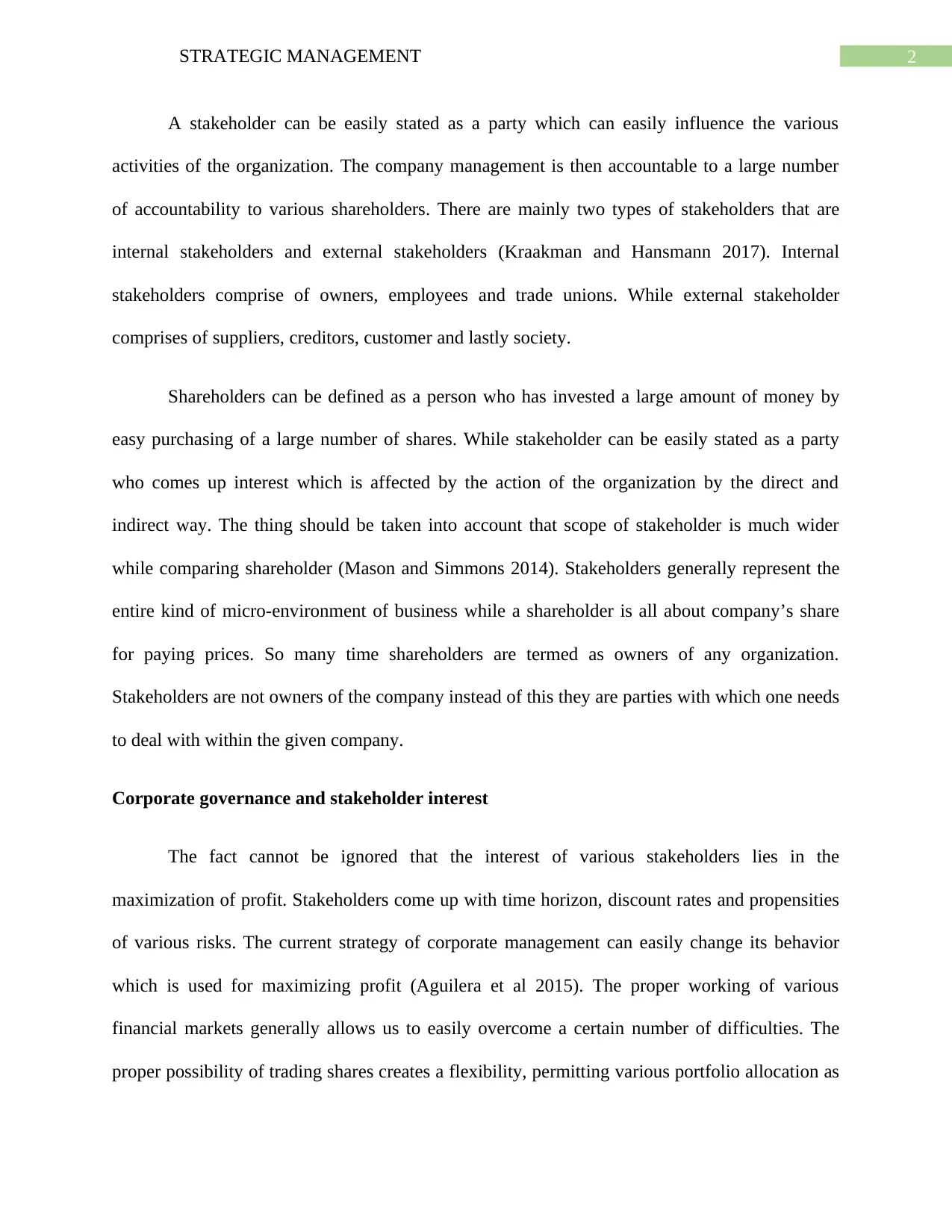
2STRATEGIC MANAGEMENT
A stakeholder can be easily stated as a party which can easily influence the various
activities of the organization. The company management is then accountable to a large number
of accountability to various shareholders. There are mainly two types of stakeholders that are
internal stakeholders and external stakeholders (Kraakman and Hansmann 2017). Internal
stakeholders comprise of owners, employees and trade unions. While external stakeholder
comprises of suppliers, creditors, customer and lastly society.
Shareholders can be defined as a person who has invested a large amount of money by
easy purchasing of a large number of shares. While stakeholder can be easily stated as a party
who comes up interest which is affected by the action of the organization by the direct and
indirect way. The thing should be taken into account that scope of stakeholder is much wider
while comparing shareholder (Mason and Simmons 2014). Stakeholders generally represent the
entire kind of micro-environment of business while a shareholder is all about company’s share
for paying prices. So many time shareholders are termed as owners of any organization.
Stakeholders are not owners of the company instead of this they are parties with which one needs
to deal with within the given company.
Corporate governance and stakeholder interest
The fact cannot be ignored that the interest of various stakeholders lies in the
maximization of profit. Stakeholders come up with time horizon, discount rates and propensities
of various risks. The current strategy of corporate management can easily change its behavior
which is used for maximizing profit (Aguilera et al 2015). The proper working of various
financial markets generally allows us to easily overcome a certain number of difficulties. The
proper possibility of trading shares creates a flexibility, permitting various portfolio allocation as
A stakeholder can be easily stated as a party which can easily influence the various
activities of the organization. The company management is then accountable to a large number
of accountability to various shareholders. There are mainly two types of stakeholders that are
internal stakeholders and external stakeholders (Kraakman and Hansmann 2017). Internal
stakeholders comprise of owners, employees and trade unions. While external stakeholder
comprises of suppliers, creditors, customer and lastly society.
Shareholders can be defined as a person who has invested a large amount of money by
easy purchasing of a large number of shares. While stakeholder can be easily stated as a party
who comes up interest which is affected by the action of the organization by the direct and
indirect way. The thing should be taken into account that scope of stakeholder is much wider
while comparing shareholder (Mason and Simmons 2014). Stakeholders generally represent the
entire kind of micro-environment of business while a shareholder is all about company’s share
for paying prices. So many time shareholders are termed as owners of any organization.
Stakeholders are not owners of the company instead of this they are parties with which one needs
to deal with within the given company.
Corporate governance and stakeholder interest
The fact cannot be ignored that the interest of various stakeholders lies in the
maximization of profit. Stakeholders come up with time horizon, discount rates and propensities
of various risks. The current strategy of corporate management can easily change its behavior
which is used for maximizing profit (Aguilera et al 2015). The proper working of various
financial markets generally allows us to easily overcome a certain number of difficulties. The
proper possibility of trading shares creates a flexibility, permitting various portfolio allocation as
⊘ This is a preview!⊘
Do you want full access?
Subscribe today to unlock all pages.

Trusted by 1+ million students worldwide
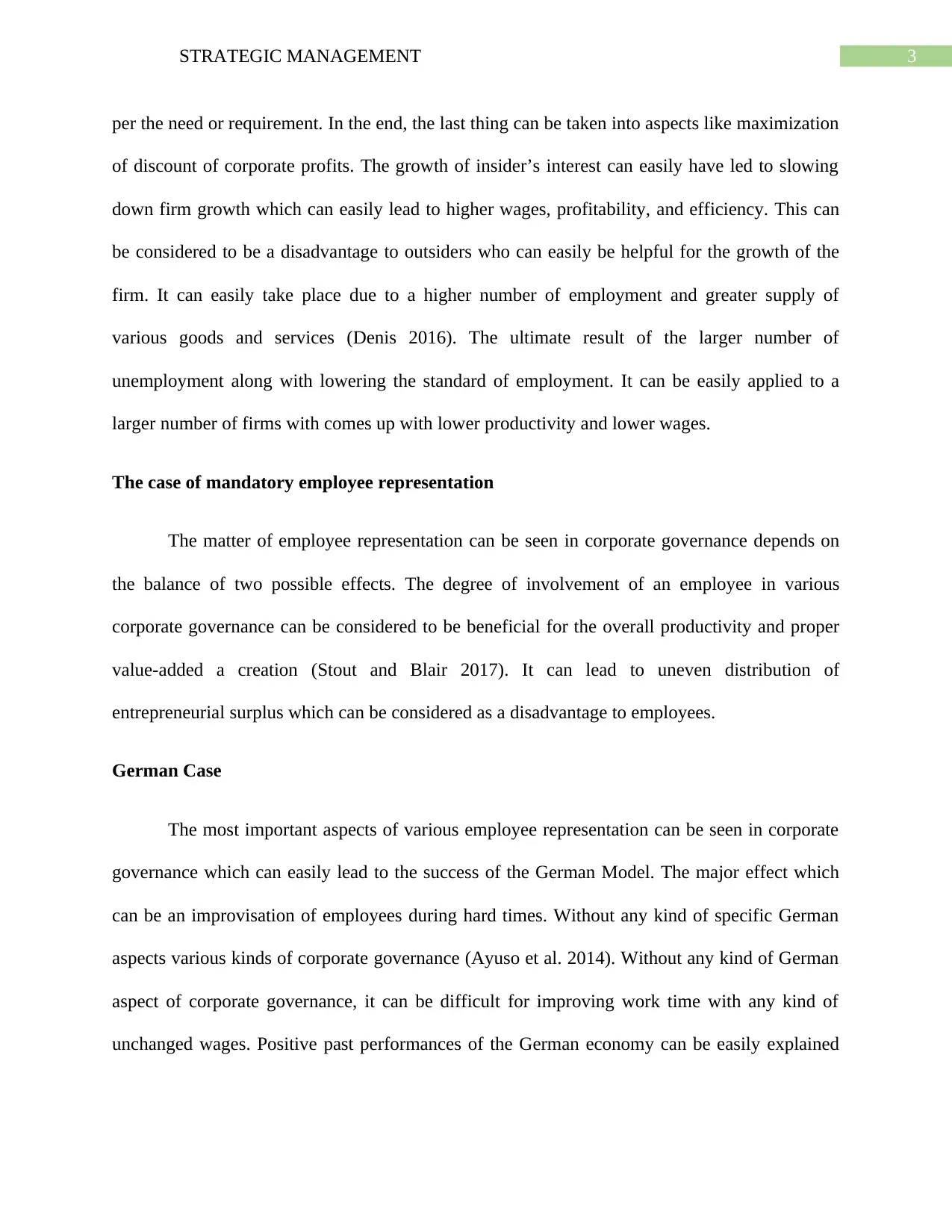
3STRATEGIC MANAGEMENT
per the need or requirement. In the end, the last thing can be taken into aspects like maximization
of discount of corporate profits. The growth of insider’s interest can easily have led to slowing
down firm growth which can easily lead to higher wages, profitability, and efficiency. This can
be considered to be a disadvantage to outsiders who can easily be helpful for the growth of the
firm. It can easily take place due to a higher number of employment and greater supply of
various goods and services (Denis 2016). The ultimate result of the larger number of
unemployment along with lowering the standard of employment. It can be easily applied to a
larger number of firms with comes up with lower productivity and lower wages.
The case of mandatory employee representation
The matter of employee representation can be seen in corporate governance depends on
the balance of two possible effects. The degree of involvement of an employee in various
corporate governance can be considered to be beneficial for the overall productivity and proper
value-added a creation (Stout and Blair 2017). It can lead to uneven distribution of
entrepreneurial surplus which can be considered as a disadvantage to employees.
German Case
The most important aspects of various employee representation can be seen in corporate
governance which can easily lead to the success of the German Model. The major effect which
can be an improvisation of employees during hard times. Without any kind of specific German
aspects various kinds of corporate governance (Ayuso et al. 2014). Without any kind of German
aspect of corporate governance, it can be difficult for improving work time with any kind of
unchanged wages. Positive past performances of the German economy can be easily explained
per the need or requirement. In the end, the last thing can be taken into aspects like maximization
of discount of corporate profits. The growth of insider’s interest can easily have led to slowing
down firm growth which can easily lead to higher wages, profitability, and efficiency. This can
be considered to be a disadvantage to outsiders who can easily be helpful for the growth of the
firm. It can easily take place due to a higher number of employment and greater supply of
various goods and services (Denis 2016). The ultimate result of the larger number of
unemployment along with lowering the standard of employment. It can be easily applied to a
larger number of firms with comes up with lower productivity and lower wages.
The case of mandatory employee representation
The matter of employee representation can be seen in corporate governance depends on
the balance of two possible effects. The degree of involvement of an employee in various
corporate governance can be considered to be beneficial for the overall productivity and proper
value-added a creation (Stout and Blair 2017). It can lead to uneven distribution of
entrepreneurial surplus which can be considered as a disadvantage to employees.
German Case
The most important aspects of various employee representation can be seen in corporate
governance which can easily lead to the success of the German Model. The major effect which
can be an improvisation of employees during hard times. Without any kind of specific German
aspects various kinds of corporate governance (Ayuso et al. 2014). Without any kind of German
aspect of corporate governance, it can be difficult for improving work time with any kind of
unchanged wages. Positive past performances of the German economy can be easily explained
Paraphrase This Document
Need a fresh take? Get an instant paraphrase of this document with our AI Paraphraser
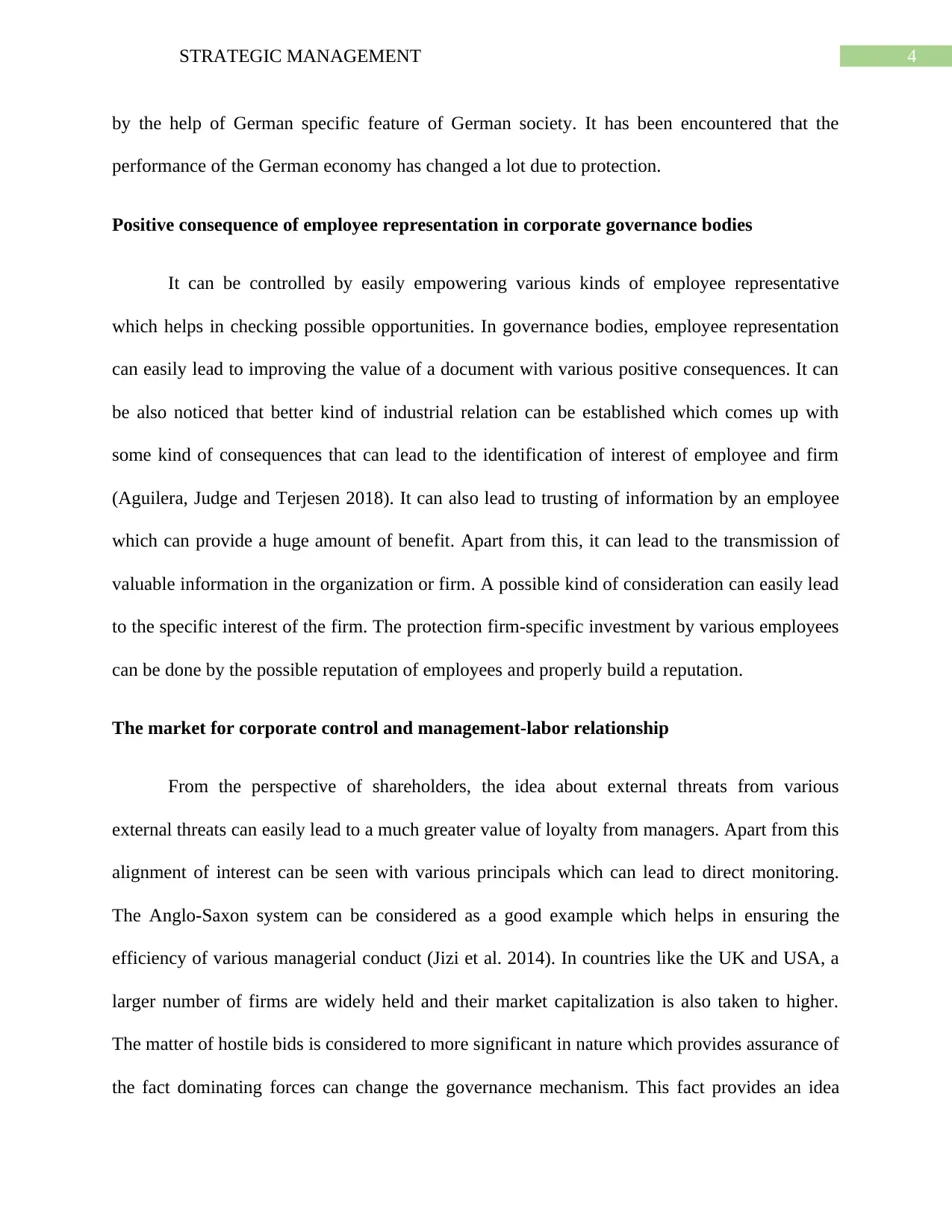
4STRATEGIC MANAGEMENT
by the help of German specific feature of German society. It has been encountered that the
performance of the German economy has changed a lot due to protection.
Positive consequence of employee representation in corporate governance bodies
It can be controlled by easily empowering various kinds of employee representative
which helps in checking possible opportunities. In governance bodies, employee representation
can easily lead to improving the value of a document with various positive consequences. It can
be also noticed that better kind of industrial relation can be established which comes up with
some kind of consequences that can lead to the identification of interest of employee and firm
(Aguilera, Judge and Terjesen 2018). It can also lead to trusting of information by an employee
which can provide a huge amount of benefit. Apart from this, it can lead to the transmission of
valuable information in the organization or firm. A possible kind of consideration can easily lead
to the specific interest of the firm. The protection firm-specific investment by various employees
can be done by the possible reputation of employees and properly build a reputation.
The market for corporate control and management-labor relationship
From the perspective of shareholders, the idea about external threats from various
external threats can easily lead to a much greater value of loyalty from managers. Apart from this
alignment of interest can be seen with various principals which can lead to direct monitoring.
The Anglo-Saxon system can be considered as a good example which helps in ensuring the
efficiency of various managerial conduct (Jizi et al. 2014). In countries like the UK and USA, a
larger number of firms are widely held and their market capitalization is also taken to higher.
The matter of hostile bids is considered to more significant in nature which provides assurance of
the fact dominating forces can change the governance mechanism. This fact provides an idea
by the help of German specific feature of German society. It has been encountered that the
performance of the German economy has changed a lot due to protection.
Positive consequence of employee representation in corporate governance bodies
It can be controlled by easily empowering various kinds of employee representative
which helps in checking possible opportunities. In governance bodies, employee representation
can easily lead to improving the value of a document with various positive consequences. It can
be also noticed that better kind of industrial relation can be established which comes up with
some kind of consequences that can lead to the identification of interest of employee and firm
(Aguilera, Judge and Terjesen 2018). It can also lead to trusting of information by an employee
which can provide a huge amount of benefit. Apart from this, it can lead to the transmission of
valuable information in the organization or firm. A possible kind of consideration can easily lead
to the specific interest of the firm. The protection firm-specific investment by various employees
can be done by the possible reputation of employees and properly build a reputation.
The market for corporate control and management-labor relationship
From the perspective of shareholders, the idea about external threats from various
external threats can easily lead to a much greater value of loyalty from managers. Apart from this
alignment of interest can be seen with various principals which can lead to direct monitoring.
The Anglo-Saxon system can be considered as a good example which helps in ensuring the
efficiency of various managerial conduct (Jizi et al. 2014). In countries like the UK and USA, a
larger number of firms are widely held and their market capitalization is also taken to higher.
The matter of hostile bids is considered to more significant in nature which provides assurance of
the fact dominating forces can change the governance mechanism. This fact provides an idea
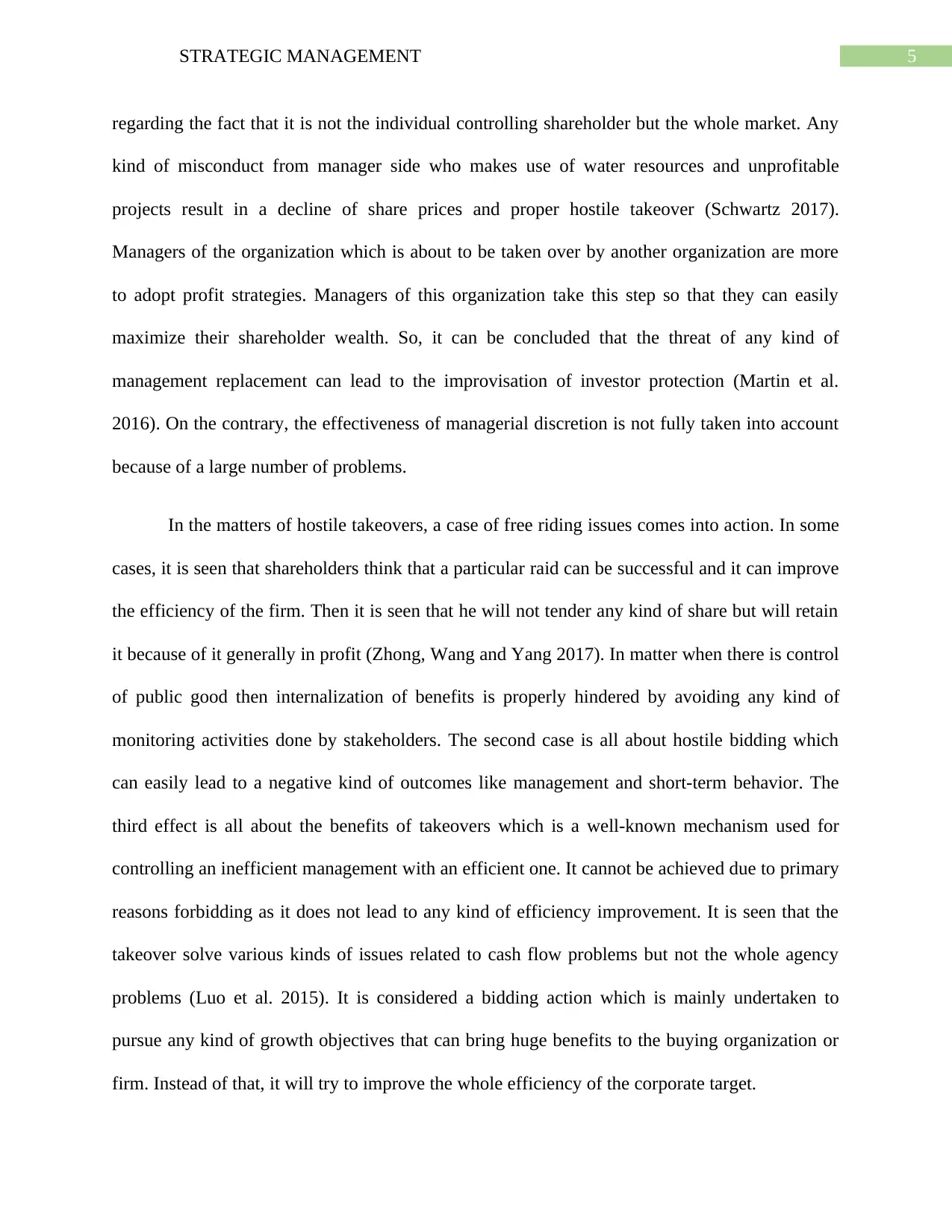
5STRATEGIC MANAGEMENT
regarding the fact that it is not the individual controlling shareholder but the whole market. Any
kind of misconduct from manager side who makes use of water resources and unprofitable
projects result in a decline of share prices and proper hostile takeover (Schwartz 2017).
Managers of the organization which is about to be taken over by another organization are more
to adopt profit strategies. Managers of this organization take this step so that they can easily
maximize their shareholder wealth. So, it can be concluded that the threat of any kind of
management replacement can lead to the improvisation of investor protection (Martin et al.
2016). On the contrary, the effectiveness of managerial discretion is not fully taken into account
because of a large number of problems.
In the matters of hostile takeovers, a case of free riding issues comes into action. In some
cases, it is seen that shareholders think that a particular raid can be successful and it can improve
the efficiency of the firm. Then it is seen that he will not tender any kind of share but will retain
it because of it generally in profit (Zhong, Wang and Yang 2017). In matter when there is control
of public good then internalization of benefits is properly hindered by avoiding any kind of
monitoring activities done by stakeholders. The second case is all about hostile bidding which
can easily lead to a negative kind of outcomes like management and short-term behavior. The
third effect is all about the benefits of takeovers which is a well-known mechanism used for
controlling an inefficient management with an efficient one. It cannot be achieved due to primary
reasons forbidding as it does not lead to any kind of efficiency improvement. It is seen that the
takeover solve various kinds of issues related to cash flow problems but not the whole agency
problems (Luo et al. 2015). It is considered a bidding action which is mainly undertaken to
pursue any kind of growth objectives that can bring huge benefits to the buying organization or
firm. Instead of that, it will try to improve the whole efficiency of the corporate target.
regarding the fact that it is not the individual controlling shareholder but the whole market. Any
kind of misconduct from manager side who makes use of water resources and unprofitable
projects result in a decline of share prices and proper hostile takeover (Schwartz 2017).
Managers of the organization which is about to be taken over by another organization are more
to adopt profit strategies. Managers of this organization take this step so that they can easily
maximize their shareholder wealth. So, it can be concluded that the threat of any kind of
management replacement can lead to the improvisation of investor protection (Martin et al.
2016). On the contrary, the effectiveness of managerial discretion is not fully taken into account
because of a large number of problems.
In the matters of hostile takeovers, a case of free riding issues comes into action. In some
cases, it is seen that shareholders think that a particular raid can be successful and it can improve
the efficiency of the firm. Then it is seen that he will not tender any kind of share but will retain
it because of it generally in profit (Zhong, Wang and Yang 2017). In matter when there is control
of public good then internalization of benefits is properly hindered by avoiding any kind of
monitoring activities done by stakeholders. The second case is all about hostile bidding which
can easily lead to a negative kind of outcomes like management and short-term behavior. The
third effect is all about the benefits of takeovers which is a well-known mechanism used for
controlling an inefficient management with an efficient one. It cannot be achieved due to primary
reasons forbidding as it does not lead to any kind of efficiency improvement. It is seen that the
takeover solve various kinds of issues related to cash flow problems but not the whole agency
problems (Luo et al. 2015). It is considered a bidding action which is mainly undertaken to
pursue any kind of growth objectives that can bring huge benefits to the buying organization or
firm. Instead of that, it will try to improve the whole efficiency of the corporate target.
⊘ This is a preview!⊘
Do you want full access?
Subscribe today to unlock all pages.

Trusted by 1+ million students worldwide
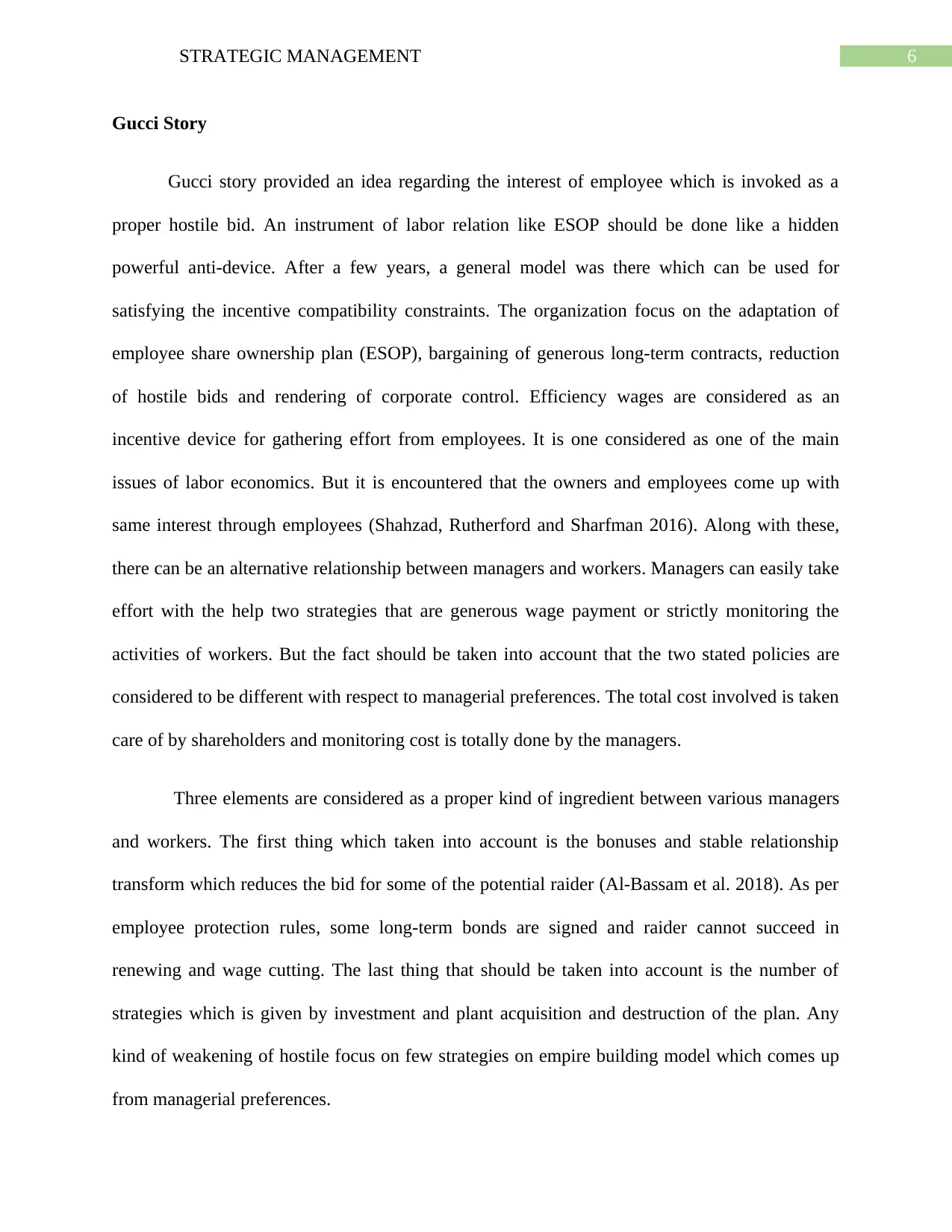
6STRATEGIC MANAGEMENT
Gucci Story
Gucci story provided an idea regarding the interest of employee which is invoked as a
proper hostile bid. An instrument of labor relation like ESOP should be done like a hidden
powerful anti-device. After a few years, a general model was there which can be used for
satisfying the incentive compatibility constraints. The organization focus on the adaptation of
employee share ownership plan (ESOP), bargaining of generous long-term contracts, reduction
of hostile bids and rendering of corporate control. Efficiency wages are considered as an
incentive device for gathering effort from employees. It is one considered as one of the main
issues of labor economics. But it is encountered that the owners and employees come up with
same interest through employees (Shahzad, Rutherford and Sharfman 2016). Along with these,
there can be an alternative relationship between managers and workers. Managers can easily take
effort with the help two strategies that are generous wage payment or strictly monitoring the
activities of workers. But the fact should be taken into account that the two stated policies are
considered to be different with respect to managerial preferences. The total cost involved is taken
care of by shareholders and monitoring cost is totally done by the managers.
Three elements are considered as a proper kind of ingredient between various managers
and workers. The first thing which taken into account is the bonuses and stable relationship
transform which reduces the bid for some of the potential raider (Al-Bassam et al. 2018). As per
employee protection rules, some long-term bonds are signed and raider cannot succeed in
renewing and wage cutting. The last thing that should be taken into account is the number of
strategies which is given by investment and plant acquisition and destruction of the plan. Any
kind of weakening of hostile focus on few strategies on empire building model which comes up
from managerial preferences.
Gucci Story
Gucci story provided an idea regarding the interest of employee which is invoked as a
proper hostile bid. An instrument of labor relation like ESOP should be done like a hidden
powerful anti-device. After a few years, a general model was there which can be used for
satisfying the incentive compatibility constraints. The organization focus on the adaptation of
employee share ownership plan (ESOP), bargaining of generous long-term contracts, reduction
of hostile bids and rendering of corporate control. Efficiency wages are considered as an
incentive device for gathering effort from employees. It is one considered as one of the main
issues of labor economics. But it is encountered that the owners and employees come up with
same interest through employees (Shahzad, Rutherford and Sharfman 2016). Along with these,
there can be an alternative relationship between managers and workers. Managers can easily take
effort with the help two strategies that are generous wage payment or strictly monitoring the
activities of workers. But the fact should be taken into account that the two stated policies are
considered to be different with respect to managerial preferences. The total cost involved is taken
care of by shareholders and monitoring cost is totally done by the managers.
Three elements are considered as a proper kind of ingredient between various managers
and workers. The first thing which taken into account is the bonuses and stable relationship
transform which reduces the bid for some of the potential raider (Al-Bassam et al. 2018). As per
employee protection rules, some long-term bonds are signed and raider cannot succeed in
renewing and wage cutting. The last thing that should be taken into account is the number of
strategies which is given by investment and plant acquisition and destruction of the plan. Any
kind of weakening of hostile focus on few strategies on empire building model which comes up
from managerial preferences.
Paraphrase This Document
Need a fresh take? Get an instant paraphrase of this document with our AI Paraphraser
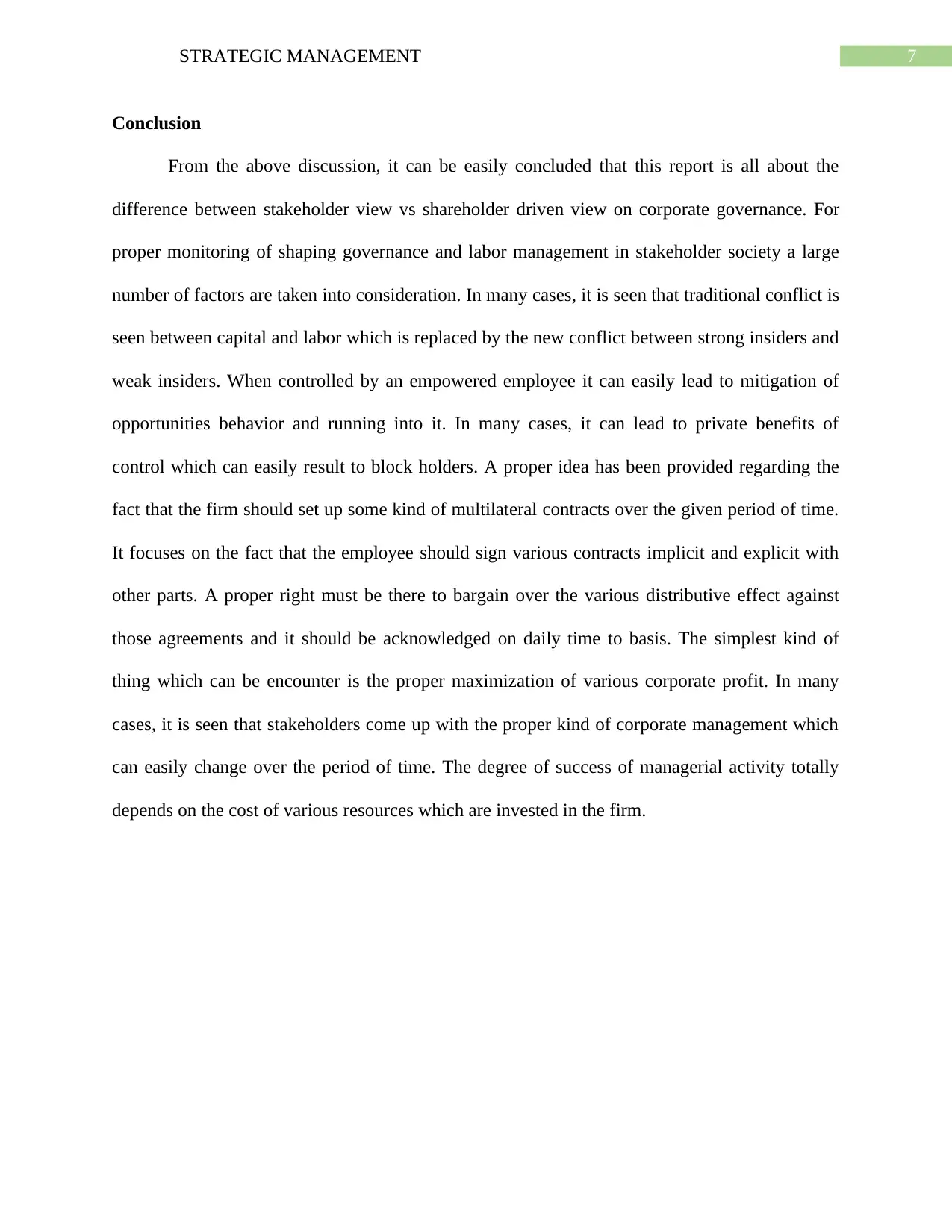
7STRATEGIC MANAGEMENT
Conclusion
From the above discussion, it can be easily concluded that this report is all about the
difference between stakeholder view vs shareholder driven view on corporate governance. For
proper monitoring of shaping governance and labor management in stakeholder society a large
number of factors are taken into consideration. In many cases, it is seen that traditional conflict is
seen between capital and labor which is replaced by the new conflict between strong insiders and
weak insiders. When controlled by an empowered employee it can easily lead to mitigation of
opportunities behavior and running into it. In many cases, it can lead to private benefits of
control which can easily result to block holders. A proper idea has been provided regarding the
fact that the firm should set up some kind of multilateral contracts over the given period of time.
It focuses on the fact that the employee should sign various contracts implicit and explicit with
other parts. A proper right must be there to bargain over the various distributive effect against
those agreements and it should be acknowledged on daily time to basis. The simplest kind of
thing which can be encounter is the proper maximization of various corporate profit. In many
cases, it is seen that stakeholders come up with the proper kind of corporate management which
can easily change over the period of time. The degree of success of managerial activity totally
depends on the cost of various resources which are invested in the firm.
Conclusion
From the above discussion, it can be easily concluded that this report is all about the
difference between stakeholder view vs shareholder driven view on corporate governance. For
proper monitoring of shaping governance and labor management in stakeholder society a large
number of factors are taken into consideration. In many cases, it is seen that traditional conflict is
seen between capital and labor which is replaced by the new conflict between strong insiders and
weak insiders. When controlled by an empowered employee it can easily lead to mitigation of
opportunities behavior and running into it. In many cases, it can lead to private benefits of
control which can easily result to block holders. A proper idea has been provided regarding the
fact that the firm should set up some kind of multilateral contracts over the given period of time.
It focuses on the fact that the employee should sign various contracts implicit and explicit with
other parts. A proper right must be there to bargain over the various distributive effect against
those agreements and it should be acknowledged on daily time to basis. The simplest kind of
thing which can be encounter is the proper maximization of various corporate profit. In many
cases, it is seen that stakeholders come up with the proper kind of corporate management which
can easily change over the period of time. The degree of success of managerial activity totally
depends on the cost of various resources which are invested in the firm.
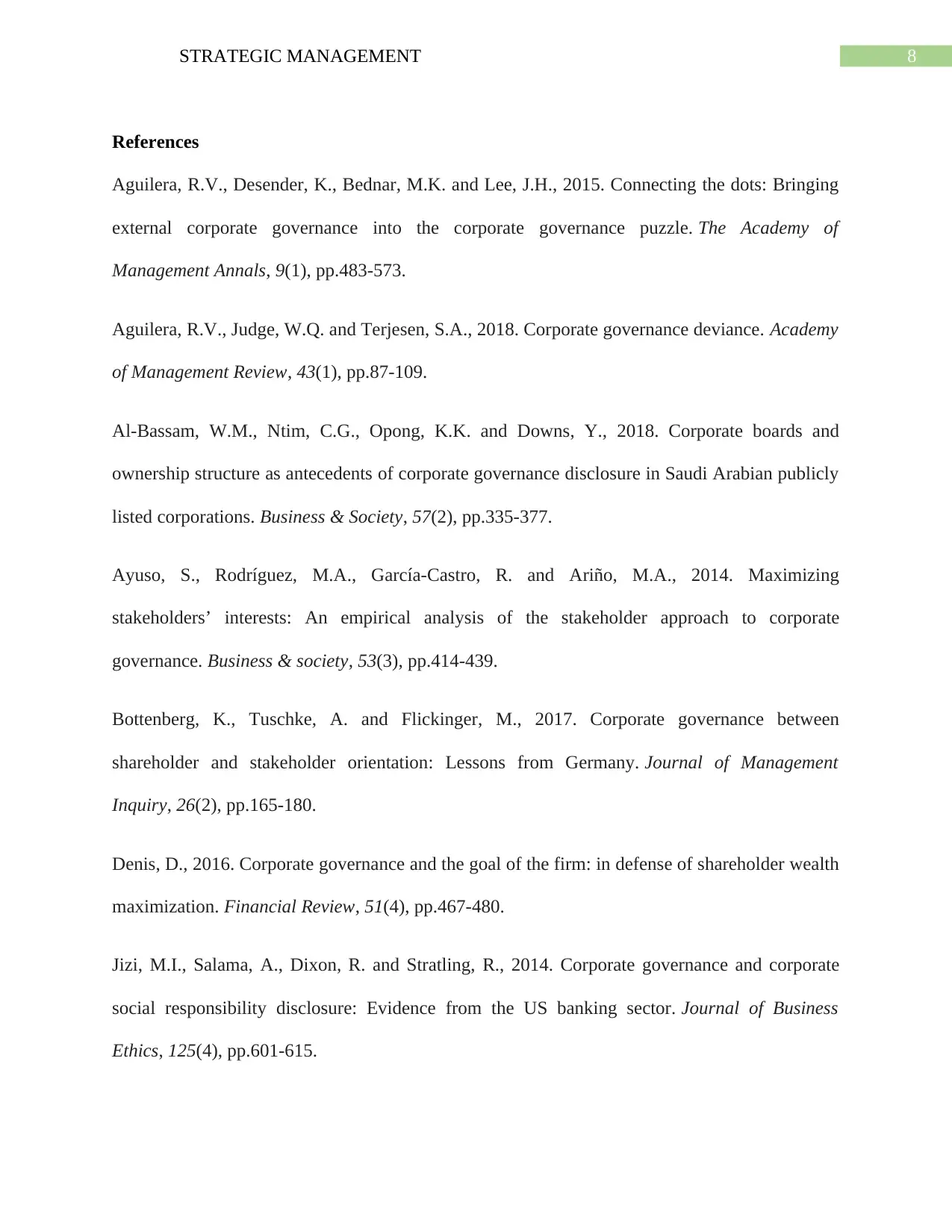
8STRATEGIC MANAGEMENT
References
Aguilera, R.V., Desender, K., Bednar, M.K. and Lee, J.H., 2015. Connecting the dots: Bringing
external corporate governance into the corporate governance puzzle. The Academy of
Management Annals, 9(1), pp.483-573.
Aguilera, R.V., Judge, W.Q. and Terjesen, S.A., 2018. Corporate governance deviance. Academy
of Management Review, 43(1), pp.87-109.
Al-Bassam, W.M., Ntim, C.G., Opong, K.K. and Downs, Y., 2018. Corporate boards and
ownership structure as antecedents of corporate governance disclosure in Saudi Arabian publicly
listed corporations. Business & Society, 57(2), pp.335-377.
Ayuso, S., Rodríguez, M.A., García-Castro, R. and Ariño, M.A., 2014. Maximizing
stakeholders’ interests: An empirical analysis of the stakeholder approach to corporate
governance. Business & society, 53(3), pp.414-439.
Bottenberg, K., Tuschke, A. and Flickinger, M., 2017. Corporate governance between
shareholder and stakeholder orientation: Lessons from Germany. Journal of Management
Inquiry, 26(2), pp.165-180.
Denis, D., 2016. Corporate governance and the goal of the firm: in defense of shareholder wealth
maximization. Financial Review, 51(4), pp.467-480.
Jizi, M.I., Salama, A., Dixon, R. and Stratling, R., 2014. Corporate governance and corporate
social responsibility disclosure: Evidence from the US banking sector. Journal of Business
Ethics, 125(4), pp.601-615.
References
Aguilera, R.V., Desender, K., Bednar, M.K. and Lee, J.H., 2015. Connecting the dots: Bringing
external corporate governance into the corporate governance puzzle. The Academy of
Management Annals, 9(1), pp.483-573.
Aguilera, R.V., Judge, W.Q. and Terjesen, S.A., 2018. Corporate governance deviance. Academy
of Management Review, 43(1), pp.87-109.
Al-Bassam, W.M., Ntim, C.G., Opong, K.K. and Downs, Y., 2018. Corporate boards and
ownership structure as antecedents of corporate governance disclosure in Saudi Arabian publicly
listed corporations. Business & Society, 57(2), pp.335-377.
Ayuso, S., Rodríguez, M.A., García-Castro, R. and Ariño, M.A., 2014. Maximizing
stakeholders’ interests: An empirical analysis of the stakeholder approach to corporate
governance. Business & society, 53(3), pp.414-439.
Bottenberg, K., Tuschke, A. and Flickinger, M., 2017. Corporate governance between
shareholder and stakeholder orientation: Lessons from Germany. Journal of Management
Inquiry, 26(2), pp.165-180.
Denis, D., 2016. Corporate governance and the goal of the firm: in defense of shareholder wealth
maximization. Financial Review, 51(4), pp.467-480.
Jizi, M.I., Salama, A., Dixon, R. and Stratling, R., 2014. Corporate governance and corporate
social responsibility disclosure: Evidence from the US banking sector. Journal of Business
Ethics, 125(4), pp.601-615.
⊘ This is a preview!⊘
Do you want full access?
Subscribe today to unlock all pages.

Trusted by 1+ million students worldwide
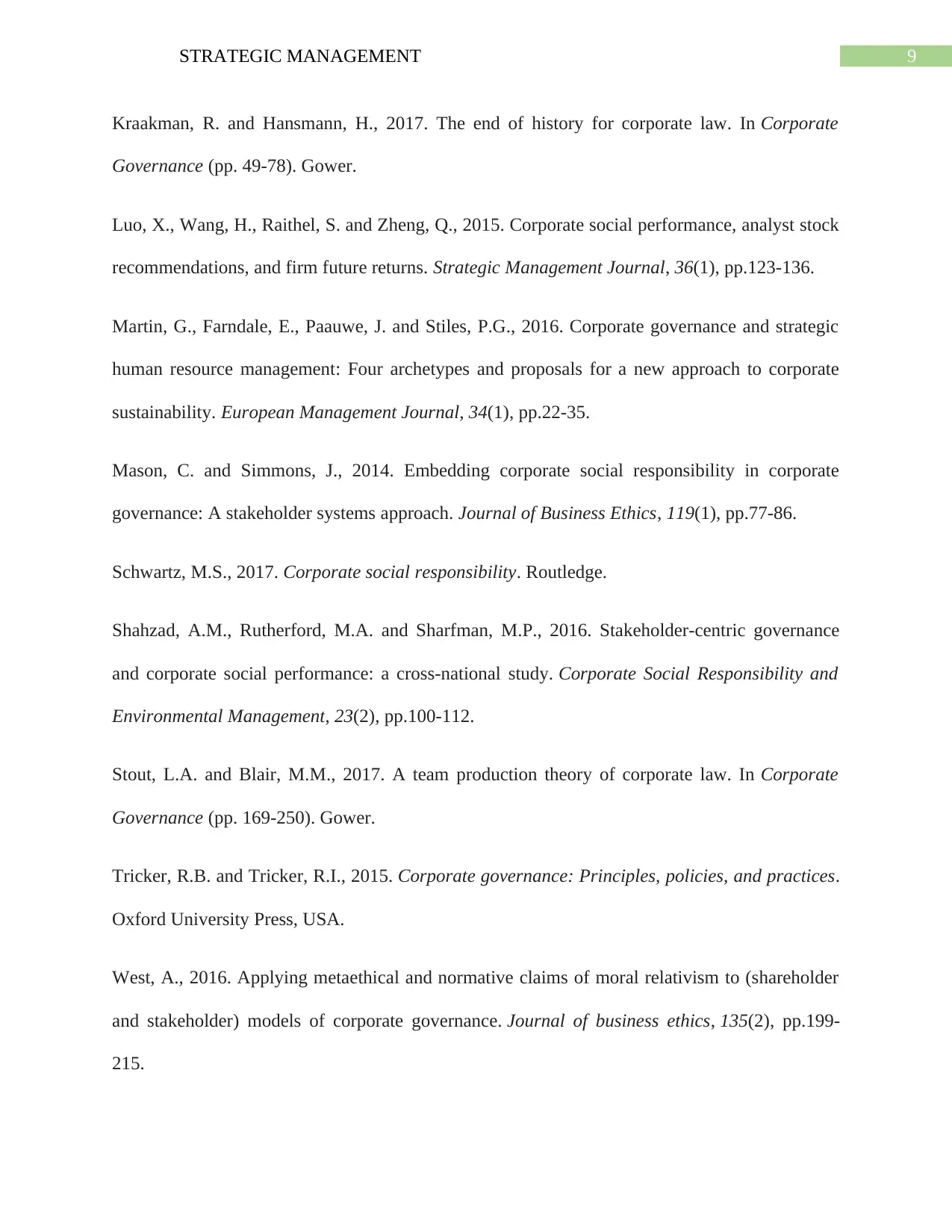
9STRATEGIC MANAGEMENT
Kraakman, R. and Hansmann, H., 2017. The end of history for corporate law. In Corporate
Governance (pp. 49-78). Gower.
Luo, X., Wang, H., Raithel, S. and Zheng, Q., 2015. Corporate social performance, analyst stock
recommendations, and firm future returns. Strategic Management Journal, 36(1), pp.123-136.
Martin, G., Farndale, E., Paauwe, J. and Stiles, P.G., 2016. Corporate governance and strategic
human resource management: Four archetypes and proposals for a new approach to corporate
sustainability. European Management Journal, 34(1), pp.22-35.
Mason, C. and Simmons, J., 2014. Embedding corporate social responsibility in corporate
governance: A stakeholder systems approach. Journal of Business Ethics, 119(1), pp.77-86.
Schwartz, M.S., 2017. Corporate social responsibility. Routledge.
Shahzad, A.M., Rutherford, M.A. and Sharfman, M.P., 2016. Stakeholder‐centric governance
and corporate social performance: a cross‐national study. Corporate Social Responsibility and
Environmental Management, 23(2), pp.100-112.
Stout, L.A. and Blair, M.M., 2017. A team production theory of corporate law. In Corporate
Governance (pp. 169-250). Gower.
Tricker, R.B. and Tricker, R.I., 2015. Corporate governance: Principles, policies, and practices.
Oxford University Press, USA.
West, A., 2016. Applying metaethical and normative claims of moral relativism to (shareholder
and stakeholder) models of corporate governance. Journal of business ethics, 135(2), pp.199-
215.
Kraakman, R. and Hansmann, H., 2017. The end of history for corporate law. In Corporate
Governance (pp. 49-78). Gower.
Luo, X., Wang, H., Raithel, S. and Zheng, Q., 2015. Corporate social performance, analyst stock
recommendations, and firm future returns. Strategic Management Journal, 36(1), pp.123-136.
Martin, G., Farndale, E., Paauwe, J. and Stiles, P.G., 2016. Corporate governance and strategic
human resource management: Four archetypes and proposals for a new approach to corporate
sustainability. European Management Journal, 34(1), pp.22-35.
Mason, C. and Simmons, J., 2014. Embedding corporate social responsibility in corporate
governance: A stakeholder systems approach. Journal of Business Ethics, 119(1), pp.77-86.
Schwartz, M.S., 2017. Corporate social responsibility. Routledge.
Shahzad, A.M., Rutherford, M.A. and Sharfman, M.P., 2016. Stakeholder‐centric governance
and corporate social performance: a cross‐national study. Corporate Social Responsibility and
Environmental Management, 23(2), pp.100-112.
Stout, L.A. and Blair, M.M., 2017. A team production theory of corporate law. In Corporate
Governance (pp. 169-250). Gower.
Tricker, R.B. and Tricker, R.I., 2015. Corporate governance: Principles, policies, and practices.
Oxford University Press, USA.
West, A., 2016. Applying metaethical and normative claims of moral relativism to (shareholder
and stakeholder) models of corporate governance. Journal of business ethics, 135(2), pp.199-
215.
Paraphrase This Document
Need a fresh take? Get an instant paraphrase of this document with our AI Paraphraser
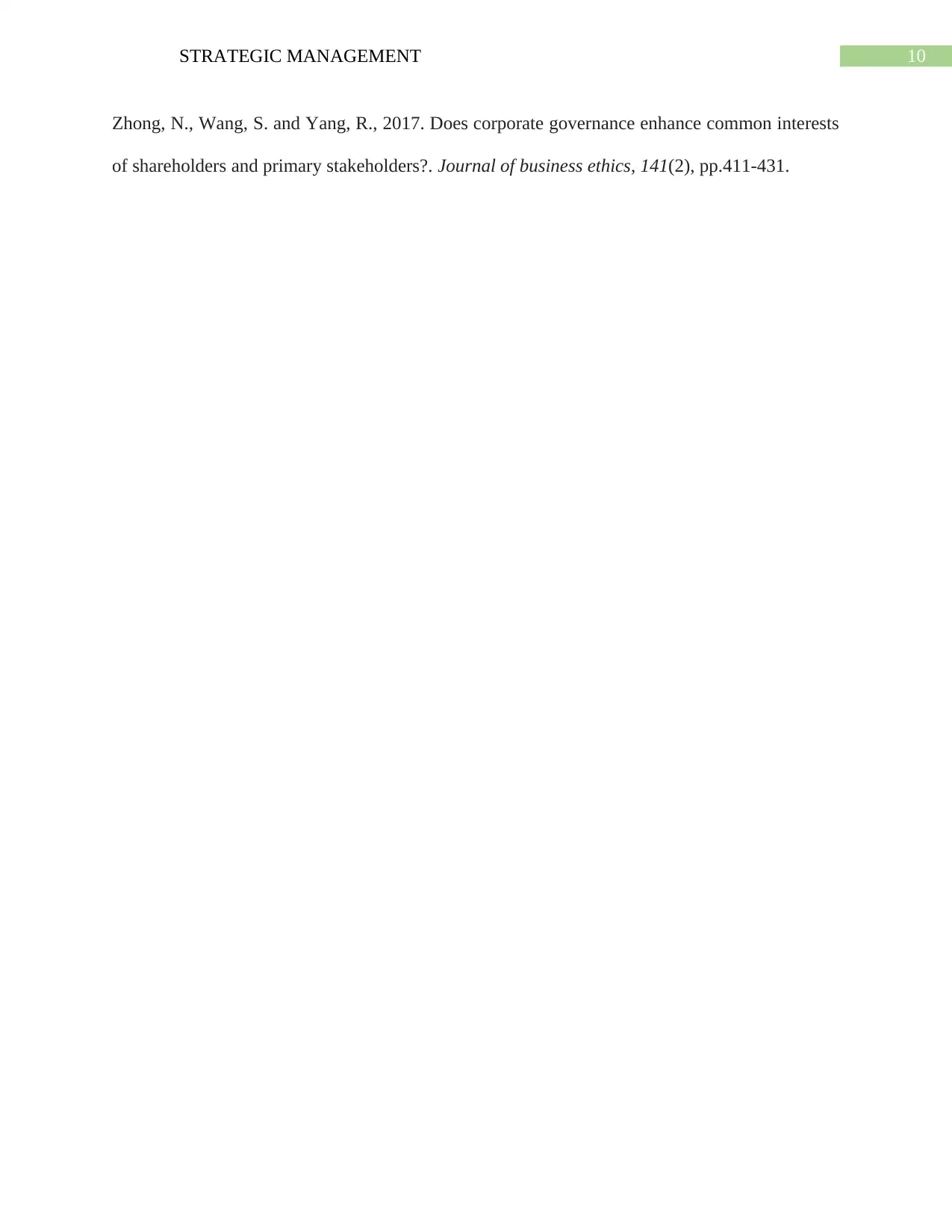
10STRATEGIC MANAGEMENT
Zhong, N., Wang, S. and Yang, R., 2017. Does corporate governance enhance common interests
of shareholders and primary stakeholders?. Journal of business ethics, 141(2), pp.411-431.
Zhong, N., Wang, S. and Yang, R., 2017. Does corporate governance enhance common interests
of shareholders and primary stakeholders?. Journal of business ethics, 141(2), pp.411-431.
1 out of 11
Related Documents
Your All-in-One AI-Powered Toolkit for Academic Success.
+13062052269
info@desklib.com
Available 24*7 on WhatsApp / Email
![[object Object]](/_next/static/media/star-bottom.7253800d.svg)
Unlock your academic potential
Copyright © 2020–2025 A2Z Services. All Rights Reserved. Developed and managed by ZUCOL.





